What are Online Selling platforms?
Online selling platforms are websites or apps that provide a marketplace for individuals or businesses to sell their products or services to customers over the internet. These platforms typically handle many technical and logistical aspects of selling online, such as hosting the website, processing payments, and handling shipping and returns.
Online selling platforms also offer various tools, services, and features such as inventory management, analytics, marketing, and customer support to support sellers.
Overall, online selling platforms provide an easy and convenient way for individuals and businesses to reach a large customer base and sell their products or services online.

Need of selling on online platforms
There are several reasons why individuals and businesses may choose to sell their products or services on online platforms:
- Reach: Online platforms can have millions of customers visiting their sites daily, providing a large customer base for sellers to reach.
- Convenience: Online platforms handle many technical and logistical aspects of selling online, such as hosting the website, processing payments, and handling shipping and returns.
- Cost-effective: Setting up and maintaining an online store can be relatively inexpensive compared to setting up a physical store.
- Data and analytics: Many online platforms provide sellers with data and analytics tools that they can use to track sales and customer behavior, helping sellers make informed business decisions.
- Marketing: Online platforms often offer tools and services to help sellers promote their products to a broader audience.
- Global market: Online platforms also offer to sell products globally, which can help to expand the market and increase sales.
- Customer Support: Online platforms also provide customer support services to help sellers handle queries and complaints, which can help to improve customer satisfaction and retain customers.
- Flexibility: Online platforms allow sellers to operate their business on their terms, such as setting their prices and working on their schedules.
Benefits of Selling on Online platforms
Selling online can provide several benefits for individuals and businesses, such as:
- Increased visibility: Online marketplaces can have millions of customers visiting their sites daily, providing a large customer base for sellers to reach.
- Cost savings: Setting up and maintaining an online store can be relatively inexpensive compared to setting up a physical store. This can help sellers to keep their costs low and improve their profit margins.
- Marketing tools: Online platforms often offer tools and services to help sellers promote their products to a broader audience. This can help to reach more customers and drive more sales.
- Automation: Many of the processes can be automated, such as inventory management, order fulfillment, shipping, and customer service, which can help to save time and increase efficiency.
Overall, selling online can help businesses increase sales, reach a wider audience, and save on costs while providing convenience, data and analytics, marketing tools, improved customer support, and automation.
Best Online Selling platforms
1. Shopify
Shopify is a popular selling platform. It is a cloud-based software that gives different features to set up and run their online Store. It comes in the list of best Online Selling platforms.
Shopify offers different templates and themes. Shopify also provides a wide range of e-commerce functionalities, such as product management, inventory management, payment processing, shipping and tax calculation, and customer management. It integrates with various payment gateways, allowing users to accept customer payments using credit cards, PayPal, and other methods. It also allows users to set up product shipping and tax rates.
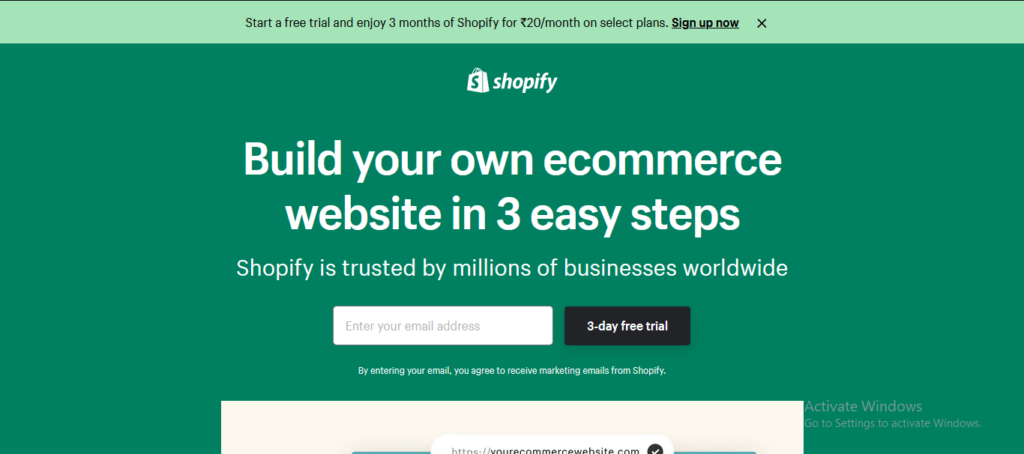
In addition, Shopify has an app store where users can find various apps and plugins to add extra functionality to their Store.
In summary, Shopify is a comprehensive and user-friendly e-commerce platform that provides everything users need to set up and run their online Store, including website design, product management, payment processing, shipping and taxes, marketing and SEO, analytics, mobile optimization, and app store.
Pros and Cons of Shopify
Pros:
- User-friendly interface: Shopify has a user-friendly interface that makes it easy for users to set up and customize their Store, even if they have little to no technical experience.
- Customizable templates and themes: Shopify offers various templates and themes for users. Allowing them to create a unique and professional-looking store.
- Comprehensive e-commerce functionalities: Shopify provides a wide range of e-commerce functionalities. Such as product management, inventory management, payment processing, shipping and tax calculation, and customer management.
- Built-in SEO and marketing tools: Shopify provides built-in SEO and marketing tools, such as email marketing, social media integration, and SEO optimization, to help users promote their Stores and products.
- Mobile optimization: Shopify stores are optimized for mobile, making it easy for customers to shop on their smartphones and tablets.
Cons:
- Transaction fees: Shopify charges transaction fees on specific payment gateways unless users use Shopify payments.
- Dependence on third-party apps: Some functionalities are only available through third-party apps. Which can be costly and may only sometimes integrate seamlessly with the platform.
- Limited scalability: Shopify may not be the best option for larger businesses with higher volumes and more complex needs.
- Limited control over hosting: Shopify handles the hosting and maintenance of the user’s Store. This can be an issue for users who prefer to have more control over their website’s hosting and maintenance.
There may be better options for larger companies or those with higher volumes and more complex needs.
2. Magento
Magento is a popular open-source selling platform. It is a popular place that gives different features. It is suitable for small and medium-sized businesses, but it is also powerful enough to handle the needs of larger enterprises that have higher volumes and more complex requirements.
Magento also provides a wide range of e-commerce functionalities, such as product management, inventory management, payment processing, shipping and tax calculation, and customer management.
Magento also provides built-in SEO and marketing tools, such as email marketing, social media integration, and SEO optimization, to help users promote their Stores and products. It also has a large developer community, which means that users can find a wide range of third-party extensions, modules, and plugins that can be easily integrated into the platform to add extra functionality.
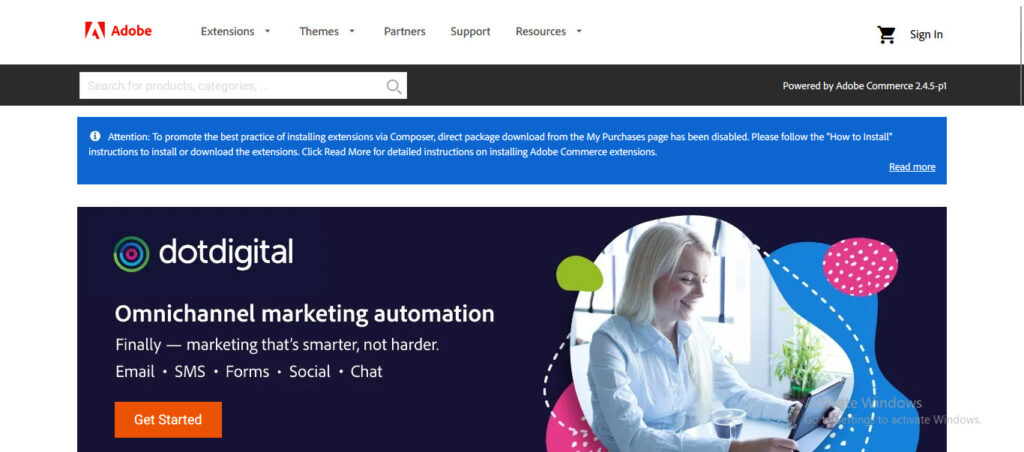
Cons of Magento. It requires a certain level of technical expertise to set up, customize and maintain a Magento store, which can be a barrier for some users.
In summary, Magento is an open-source, highly flexible, and scalable e-commerce platform that provides a wide range of features and tools to help users set up and run their online Stores. It is suitable for small and large businesses but requires a certain level of technical expertise to set up, customize and maintain a Magento store.
Magento pricing and plans
Magento is an open-source e-commerce platform, which means that the basic version of the software can be downloaded and used for free. However, paid versions of Magento are also available, which offer additional features and support.
The paid version of Magento is called Magento Commerce. It offers two pricing plans:
- Magento Commerce Cloud: This is a cloud-based subscription service that offers a range of features and services, including hosting, security, performance, and backups. The cost of this plan depends on the user’s specific needs and is typically priced on a usage-based model.
- Magento Commerce On-Premises: This plan is for users who prefer to host the software on their servers. The cost of this plan depends on the number of products in the user’s catalog and the number of orders per year.
Both plans come with various features and support options, such as a dedicated account manager, 24/7 technical support, and access to the Magento Marketplace. In addition, users can also opt for a third-party hosting service, which can vary in price depending on the provider and the user’s specific needs.
It’s worth noting that, in addition to the software and hosting costs, users will also need to pay for any third-party plugins, extensions, or custom development they need, which can add up.
Magento offers a free, open-source, and paid version with two different plans, Magento Commerce Cloud and Magento Commerce On-Premises. The pricing of the paid version depends on the user’s specific needs and can vary depending on the number of products, orders, and support level required.
3. Amazon
Amazon is a global e-commerce platform that allows individuals and businesses to sell a wide range of products to customers worldwide. It is one of the world’s largest e-commerce platforms and offers customers a wide range of products and services, including books, electronics, clothing, and food.
Amazon offers several ways for individuals and businesses to sell on its platform:
- Amazon Marketplace: This online marketplace allows individuals and businesses to sell new and used items to customers around the world. Sellers can list their products on the market, set their prices, and handle their shipping and customer service.
- Amazon Handmade: This marketplace focuses on handmade, vintage, and unique items.
Amazon also offers various tools, services, and features such as analytics, marketing, and customer support to support sellers. Overall, Amazon is a large and established e-commerce platform that provides a convenient and cost-effective way for individuals and businesses to reach a large customer base and sell their products or services online.
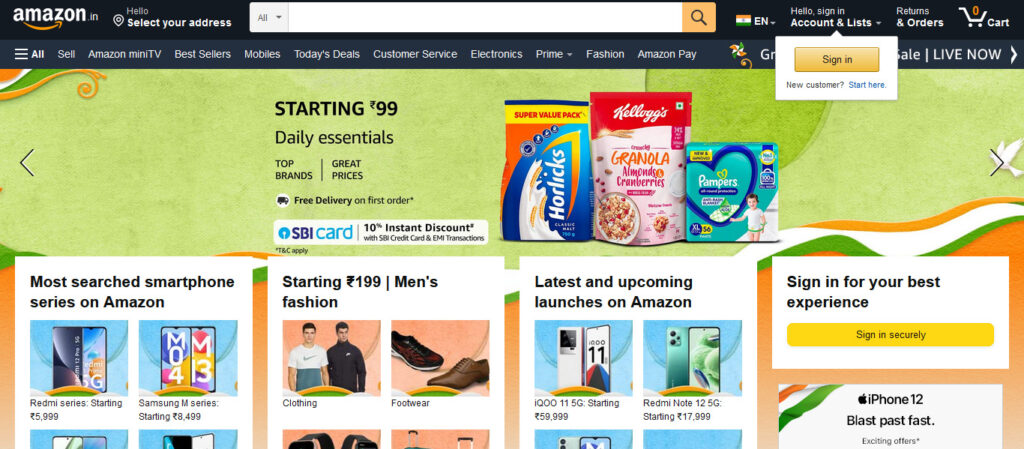
Pros and Cons of Amazon
Amazon is a widely popular e-commerce platform, but like any other platform, it has its own pros and cons.
Pros:
- Large customer base: Amazon has a vast customer base, providing a large audience for sellers to reach and potentially drive more sales.
- Convenience: Amazon handles many technical and logistical aspects of selling online, such as hosting the website, processing payments, and handling shipping and returns.
- Trust: Amazon is a well-established and trusted brand that can help increase customer trust in a seller’s products or services.
- Marketing: Amazon offers various tools and services to help sellers promote their products to a broader audience.
- Analytics: Amazon provides detailed analytics and reporting tools to help sellers track sales, customer behavior, and other essential metrics.
Cons:
- Fees: Amazon charges various fees for its services, such as a commission on each sale and a monthly subscription fee for professional sellers.
4. Bonanza
Bonanza is a popular online selling place and comes in the list of top-selling platforms. It offers several ways for individuals and businesses to sell on its platform:
- Online marketplace: This online marketplace allows individuals and businesses to sell new and used items to customers worldwide. Sellers can list their products on the market, set their prices, and handle their shipping and customer service.
- Shopping cart integration: It integrates with various shopping carts platforms, such as Shopify and BigCommerce, allowing users to easily import their products to Bonanza.
- Drop-shipping: Bonanza allows sellers to list drop-shipping products on their marketplace and handle the sale’s shipping and customer service aspects.
- Bonanza Booth: This feature allows sellers to create a branded store on Bonanza, which they can use to promote their products and brand.
It also offers various tools and services to support sellers, such as analytics, marketing, and customer support. They charge a listing fee for items and a commission on each sale.

Bonanza pricing and plans
- Basic: This free plan allows sellers to list an unlimited number of items for free. But it charges a 3.5% commission on each sale.
- Plus: This is a paid plan that costs $25 per month, eliminating the commission on sales. And offers features such as custom branding, advanced analytics, and priority support.
- Pro: This is a paid plan that costs $75 per month. It offers all the features of the Plus plan, and additionally, it gives sellers access to a dedicated account manager and additional marketing tools.
- Enterprise: this is a custom plan which is tailored to the needs of large-scale businesses, and it includes additional features such as integration with other platforms, inventory management, and advanced reporting.
In addition to the listing fee and commission, sellers will also need to pay for additional services such as shipping, customer service, and marketing.
It offers a variety of pricing plans to suit the needs of different sellers. From a free basic plan to a custom enterprise plan. The pricing plans vary regarding the features and support provided and the commission on sales.
5. Chairish
Chairish is an online marketplace specializing in vintage and pre-owned furniture and home decor. It allows individuals and businesses to sell a wide range of vintage, pre-owned, and new furniture and decor products to customers worldwide.
- Online marketplace: This online marketplace allows individuals and businesses to sell vintage, pre-owned, and new furniture and decor products to customers worldwide. Sellers can list their effects on the market, set their prices, and handle their shipping and customer service.
- White Glove Service: This is a full-service offering that allows sellers to consign their items to Chairish and have them handle the shipping, styling, photography, and customer service aspects of the sale.
- Trade Program: This program allows professional designers and trade industry professionals to purchase items on Chairish with a trade discount.
Chairish also offers various tools and services to support sellers, such as analytics, marketing, and customer support. They charge a commission on each sale. It comes in the list of best Online Selling platforms.
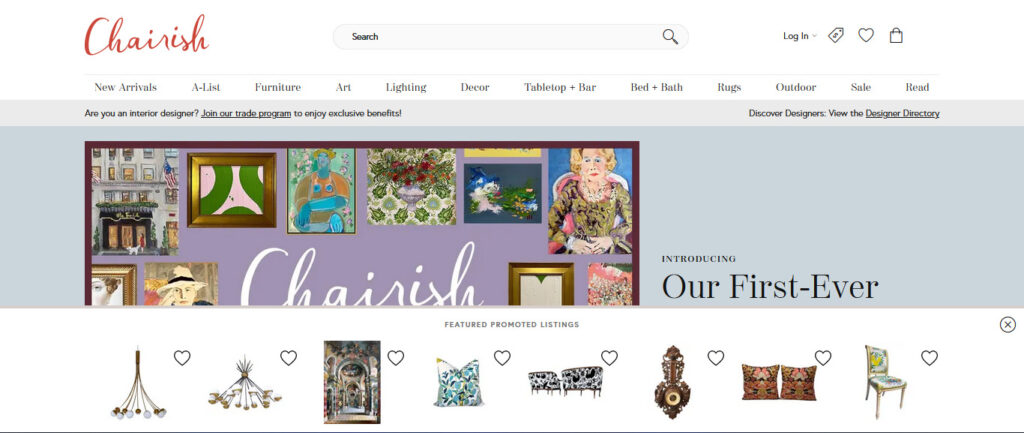
Chairish is an online marketplace specializing in vintage, pre-owned, and new furniture and home decor items. It provides a platform for individuals and businesses to sell their products and offers a variety of selling options, such as its online marketplace, White Glove Service, and Trade Program, and provides support with services such as analytics, marketing, and customer service.
Pros and Cons of Chairish
Pros:
- Specialized marketplace: Chairish focuses on vintage and pre-owned furniture and home decor. Which allows sellers to reach a specific and interested audience.
- Support: Chairish provides various tools and services such as analytics, marketing, and customer support to support sellers.
Cons:
- Commission: Chairish charges a commission on each sale, which can cut into sellers’ profits.
- Limited product range: As Chairish specializes in vintage and pre-owned furniture and home decor, it may not be suitable for sellers of new or other types of products.
- White Glove service cost: The White Glove service can be high, especially for items of high value.
- Competition: Chairish is a specialized marketplace. There may be less competition in the number of sellers, but there may still be a lot of competition for certain types of products.
6. Craigslist
Craigslist is a popular and most used online selling place. It is a local platform, which means that listings are organized by geographic area and are typically only visible to users in the same region. Craigslist is a free platform, and it’s easy to use. Users can create an account and post their listings, including images, prices, and contact information.
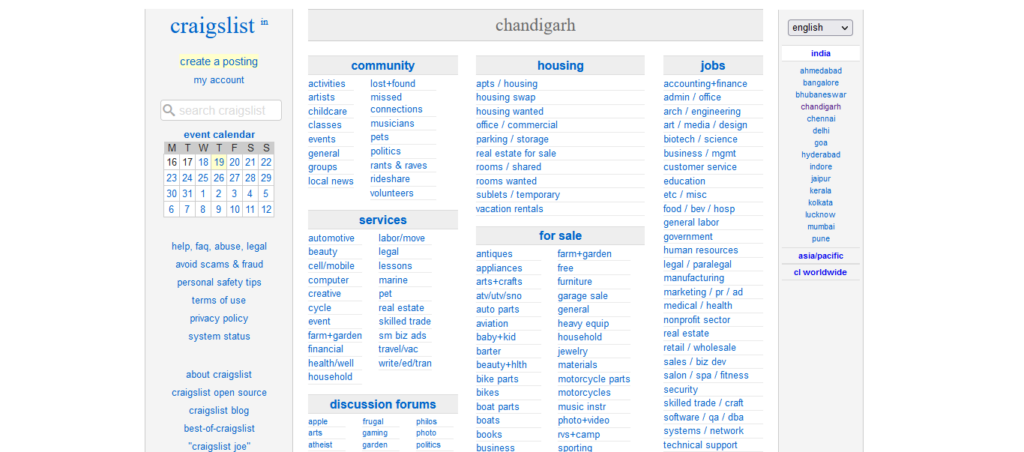
Craigslist is a popular platform for buying and selling furniture, electronics, and vehicles and finding housing rentals, jobs, and services. Users should be cautious when buying or selling items and use safe buying and selling practices like meeting in person at a public place.
Overall, Craigslist is a free and easy-to-use platform that allows individuals and businesses to list items for sale, job openings, housing rentals, and other services in their local area. It comes in the list of best Online Selling platforms. It is a popular platform for buying and selling items. But users should use caution when buying or selling items and use safe buying and selling practices.
7. eBay
eBay is a selling place. eBay offers several ways for individuals and businesses to sell on its platform:
- Online marketplace: This online marketplace allows individuals and businesses to sell new and used items to customers worldwide. Sellers can list their products on the market, set their prices, and handle their shipping and customer service.
- eBay Stores: This is a paid service that allows sellers to create a branded store on eBay and offer a variety of features such as customized pages and branding, discounted fees, and inventory management.
- eBay Valet: This service allows sellers to send their items to eBay and handle the listing, shipping, and customer service aspect of the sale.
It also offers various tools, services, and features such as analytics, marketing, and customer support to support sellers. They charge a fee for their service. Either as a percentage of the sale or a monthly subscription for eBay Stores.
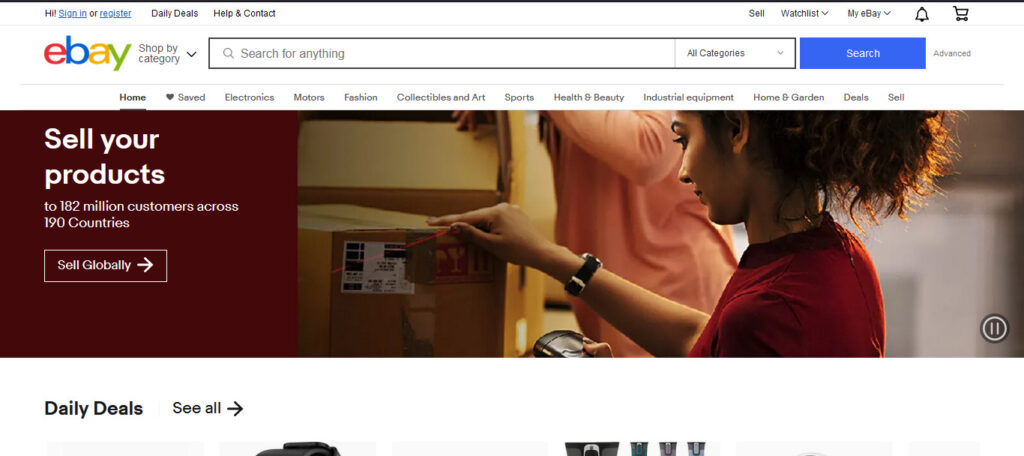
Overall, eBay is a large and established e-commerce platform that provides a convenient and cost-effective way for individuals and businesses to reach a large customer base and sell their products or services online. It comes in the list of best Online Selling platforms. It offers different selling options, such as its online marketplace, eBay Stores, and eBay Valet, and provides support with services such as analytics, marketing, and customer service.
Pros and Cons of eBay
Pros:
- Large customer base: eBay has a vast customer base, providing a large audience for sellers to reach and potentially drive more sales.
- Convenience: eBay handles many technical and logistical aspects of selling online. Such as hosting the website, processing payments, and handling shipping and returns.
- Trust: eBay is a well-established and trusted brand that can help increase customer trust in a seller’s products or services.
- Marketing: eBay offers various tools and services to help sellers promote their products to a broader audience.
- eBay Valet: This service allows sellers to send their items to eBay and have them handle the sale listing, shipping, and customer service aspect.
- Analytics: eBay provides detailed analytics and reporting tools to help sellers track sales, customer behavior, and other essential metrics.
Cons:
- Fees: eBay charges various fees for its services, including a final value fee on each sale and a monthly subscription fee for the Store.
- Loss of control: When using eBay Valet, sellers give up control over the listing, shipping, and customer service aspect of the sale.
8. Etsy
Etsy is a popular selling website. It is a marketplace that connects buyers with independent sellers around the world. Sellers can open their online shops on Etsy and list their products for sale, setting their prices, shipping options, and policies.
Etsy is geared towards unique and special items rather than mass-produced products. It is famous for handmade items such as jewelry, clothing, home decor, and craft supplies, and vintage items such as antiques and collectibles. Additionally, Etsy allows sellers to sell digital items such as printable artwork, patterns and templates, and digital downloads.
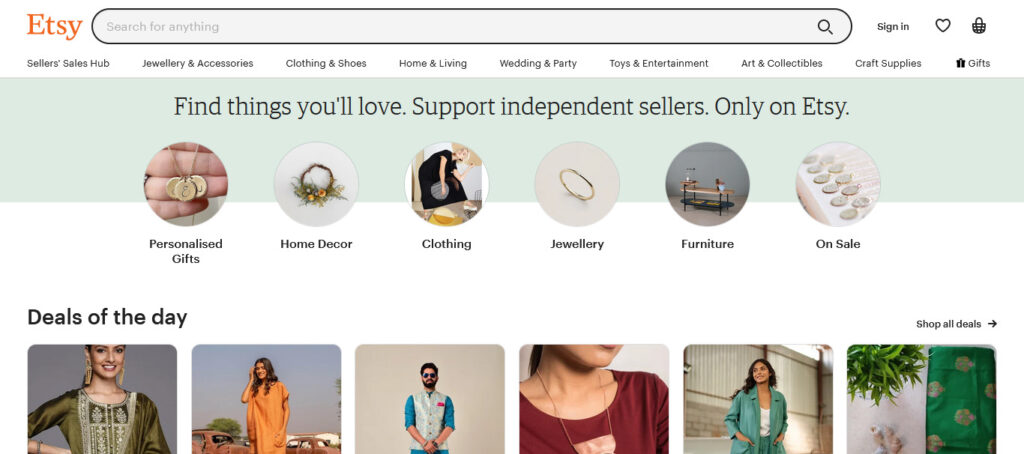
It provides various tools and services to help sellers run and grow their businesses. Such as analytics, marketing, and customer support, and offers a mobile app for buyers and sellers.
Etsy has a large and active community of buyers and sellers. And it is an excellent platform for those who want to sell unique and special items. Reach a large audience, and benefit from the support and resources provided by Etsy. It comes in the list of best Online Selling platforms.
Etsy pricing and plans
It is an online marketplace that charges fees for individuals and businesses to sell on its platform.
- Listing Fees: Etsy charges a $0.20 fee for each item listed for sale on the platform.
- Payment Processing Fees: Etsy partners with various payment processors, such as PayPal and Stripe, to handle transactions on the platform.
- Shipping Fees: Sellers are responsible for setting and charging their shipping fees.
- Advertising Fees: Sellers can purchase advertising for their listings on Etsy, increasing visibility and driving more sales. Advertising costs vary depending on the type and duration of the ad.
- Pattern fees: For sellers using the pattern service. There is a 20-cent listing fee for each digital listing and a 5% transaction fee on each sale.
- Wholesale fees: For sellers using the wholesale service. There is a 20-cent listing fee for each listing and a 3.5% transaction fee on each sale.
It’s worth noting that fees can vary based on the location of the seller and the currency they choose to list and sell their products in.
9. Facebook Marketplace
Facebook Marketplace is a popular feature available on Facebook. Users can list items for sale by creating a post on Facebook and selecting the “Sell” option. They can include a description, photos, and a price for the item. Buyers can search for articles by category or location and contact the seller through Facebook’s messaging system to make a purchase. Facebook Marketplace is one of the top-selling platforms.

It is easy to use and can be accessed directly from the Facebook app. However, as it is a peer-to-peer platform, there’s no screening process for listings. So it’s essential for users to use caution when buying or selling items and to meet in person at a public place for the transaction.
It is a convenient, easy-to-use, and free platform, but as it’s a peer-to-peer platform. It’s essential for users to use caution when buying or selling items and to meet in person at a public place.
10. Nextdoor
Nextdoor is a social networking platform that connects neighbors and local businesses. It is a platform that allows neighbors to share information, ask for recommendations, and buy and sell items within their local community. It comes in the list of best Online Selling platforms.
Users can create an account and join their neighborhood’s Nextdoor network to share information. Ask for recommendations, and buy and sell items. Nextdoor is location-based, meaning users can only see posts and listings within their neighborhoods or surrounding areas.

It also provides a platform for people to buy and sell items within their local community. Which can be convenient for buyers and sellers. But, as with any online marketplace. It’s essential for users to use caution when buying or selling items and to meet in person at a public place for the transaction.
Nextdoor pricing and plans
Nextdoor is a social networking platform that is free for individuals and businesses to use. It makes money through partnerships with local businesses. Which can pay to advertise on the platform and promote their products and services to the community.
However, while there are no direct fees for buying and selling on Nextdoor. It is essential to keep in mind that Nextdoor is a peer-to-peer platform and there is no screening process for listings. Therefore, it is necessary to use caution when buying or selling items and to meet in person at a public place for the transaction.
11. Newegg
Newegg is an online marketplace specializing in technology products such as computers, electronics, and gaming gear. It is one of the largest e-commerce platforms for technology products in the United States and offers customers a wide range of products and services. It comes in the list of best Online Selling platforms.
Newegg allows both individuals and businesses to sell their products through their platform. Sellers can list their effects on the marketplace, set their prices, and handle their shipping and customer service. It charges a commission on each sale and has a subscription service for sellers. Offering additional features like bulk listing tools, discounted fees, and more.
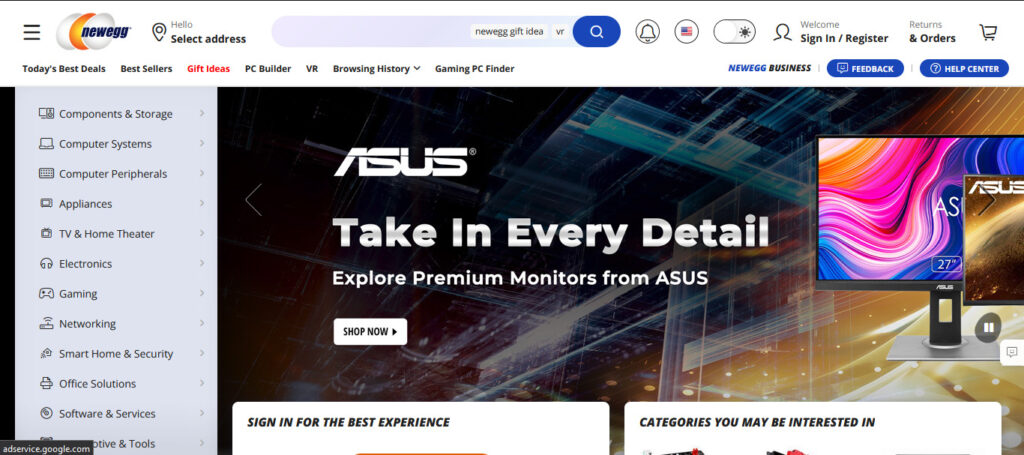
Newegg also provides various tools, services, and features such as analytics, marketing, and customer support to support sellers. They also have a robust return policy for buyers to ensure satisfaction.
Newegg is a large and established e-commerce platform specializing in technology products such as computers, electronics, and gaming gear. It provides a convenient and cost-effective way for individuals and businesses to reach a large customer base and sell their technology products online. It offers different selling options and includes analytics, marketing, and customer service services support.
Newegg Pricing and Plans
Newegg offered several different membership plans for its customers. Including a free membership and paid plans with additional benefits such as free returns, expedited shipping, and special promotions. Some of the projects are:
- Newegg Premier: This paid membership plan offers free expedited shipping, free returns, and access to exclusive deals and promotions.
- Marketplace Seller: This is a plan for individuals and businesses selling products on Newegg. The fees for this plan will vary depending on the specific items sold and the sales volume.
12. Ruby lane
Ruby Lane has been around since 1998 and is known for its high-quality, curated selection of items. It offers a platform for individual sellers to list and sell their items. Focusing on vintage and antique items such as jewelry, pottery, glass, art, and furniture.
Sellers on Ruby Lane pay a monthly fee to list their items for sale on the site. As well as a commission on each sale. Ruby Lane offers various services to help sellers market their items, such as professional photography and advertising.
It’s also known for its strict vetting process for sellers, ensuring that only high-quality, authentic items are listed for sale on the site. It comes in the list of best Online Selling platforms.
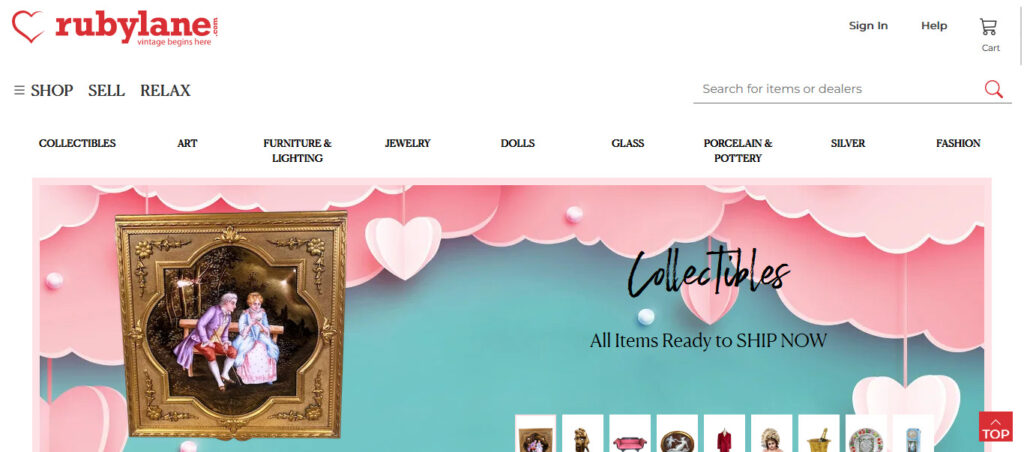
Pros and Cons of Ruby Lane
Pros:
- Ruby Lane has a reputation for being a reputable and trustworthy marketplace. With a loyal customer base specifically interested in vintage and antique items.
- The site is easy to navigate and has a clean, professional layout that helps showcase items for sale.
- Ruby Lane offers various services to help sellers market their items. Such as professional photography and advertising, which can help increase visibility and sales.
- The site has a strict vetting process for sellers, ensuring that only high-quality, authentic items are listed for sale.
Cons:
- The marketplace is highly competitive, with a large number of sellers vying for the attention of buyers.
- The site may not be the best option for sellers looking to move large quantities of items quickly. As the focus is on vintage and antique items.
- Ruby Lane is a niche marketplace, so there may be better choices for sellers looking to reach a broader audience.
Ruby Lane is an excellent option for sellers looking to reach a specific, targeted audience of buyers interested in vintage and antique items. However, the marketplace’s high fees and competitive nature may only make it the best choice for some sellers.
13. Pixpa
Pixpa offers e-commerce functionality as part of its website building and hosting platform. This allows users to sell their work directly from their website without using a separate e-commerce platform.
- Payment gateway integration: Pixpa supports a wide range of payment gateway options. Including Stripe, PayPal, Square, and more, to make it easy for customers to make purchases on your website.
- Tax and shipping: Pixpa allows you to set up taxes and shipping rates for your products. And it will automatically calculate these costs for customers during checkout.
- Order management: Pixpa provides tools to manage and track orders. Including the ability to view order history, update order status, and print invoices and shipping labels.
- Secure checkout: Pixpa uses SSL (Secure Sockets Layer) encryption to ensure that all transactions and customer information are kept safe during checkout.
Overall, Pixpa’s e-commerce functionality is an excellent solution for photographers, artists, and other creatives who want to sell their work directly from their website. It comes in the list of best Online Selling platforms.
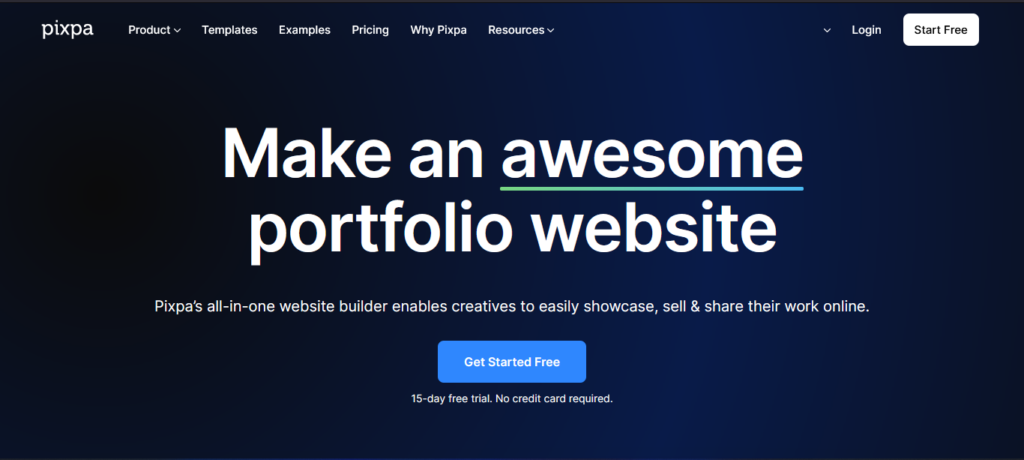
Pixpa Pricing and Plans
- Starter Plan: This free plan allows you to create an essential website and includes basic features such as a custom domain and a limited number of pages.
- Pro Plan: This plan starts at $6/month and includes additional features such as e-commerce functionality, a custom domain, and more pages.
- Advanced Plan: This plan starts at $12/month and includes additional features such as client proofing, password-protected galleries, and Google Analytics integration.
- Business Plan: This plan starts at $20/month and includes additional features such as priority support, custom code, and the ability to sell subscriptions and memberships.
Additional costs may be involved, such as credit card processing fees when using specific payment gateways and domain name registration fees if you choose to use a custom domain name that you still need to own.
Tips for choosing a successful Online Selling Platform
When selecting an online selling platform, there are a few key factors to consider:
- Fees: Different platforms have different fee structures, so it’s essential to understand how much each forum will cost you in terms of listing fees, transaction fees, and other charges.
- Ease of use: Make sure the platform is user-friendly and easy for you to navigate and manage your Store.
- Payment processing: Consider the payment options available on the platform and their associated fees.
- Customization: If you want your Store to have a unique look and feel, check if the platform allows for customizations such as themes and templates.
- Integration: If you are using other tools for your business, check if the platform integrates with them.
- Business model: Consider if the platform is suitable for your business model. For example, if you are planning to sell digital goods or subscriptions or if you are planning to handle the logistics of delivery and shipping.
It’s also a good idea to read reviews and ask for recommendations from other sellers before deciding.






 Top 10 Social Media Marketing Trends For 2024
Top 10 Social Media Marketing Trends For 2024